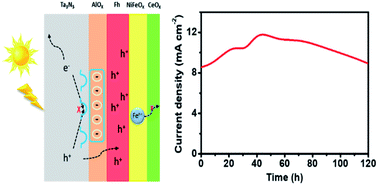Interface engineering with an AlOx dielectric layer enabling an ultrastable Ta3N5 photoanode for photoelectrochemical water oxidation†
Abstract
Photoelectrochemical water splitting is a promising approach for solar energy to chemical energy conversion. However, the development of highly stable and efficient photoanodes still remains a great challenge. Here we demonstrate an ultrastable Ta3N5 photoanode modified with an AlOx dielectric layer and a hole storage layer (ferrihydrite, Fh). It is found that the AlOx layer not only reduces the formation of interfacial trap states of Ta3N5, but also promotes the separation of photogenerated charges. This bilayer synergistically promotes the extraction and transfer of photogenerated holes from Ta3N5 to the NiFeOx cocatalyst. As a result, the Ta3N5 based photoanode exhibits significant inhibition of photocorrosion, and achieves an ultrastable photocurrent generation of 11.8 mA cm−2 at 1.23 V vs. the reversible hydrogen electrode (RHE) over 120 hours. This work reveals the crucial role of the AlOx dielectric layer in rational interface engineering of photoelectrodes.



 Please wait while we load your content...
Please wait while we load your content...